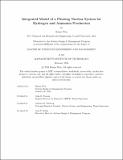Integrated Model of a Floating Nuclear System for Hydrogen and Ammonia Production
Author(s)
Won, Hanna
DownloadThesis PDF (5.471Mb)
Advisor
Parsons, John E.
Forsberg, Charles W.
Terms of use
Metadata
Show full item recordAbstract
Hydrogen’s role as a potential substitute for fossil fuels is expanding, offering significant potential to lower carbon emissions in critical sectors. Similarly, ammonia is stepping into the spotlight as both a substitute for conventional fuels in heavy industries and as an efficient hydrogen carrier. Nuclear Power Plants (NPPs) play a critical role in this scenario, offering a steady supply of low-carbon energy. This thesis explores the economic and environmental viability of an innovative marine-based facility for generating green hydrogen and ammo- nia using nuclear reactors. It analyzes various designs of this integrated floating platform, assessing their economic and environmental benefits, particularly focusing on enhancing op- erational flexibility and increasing the platform’s value. This includes selling electricity to the grid at times of peak electricity prices. The system optimizes operations by storing excess hydrogen during normal operation, ensuring continuous ammonia production during peak electricity hours. The research investigates diverse NPPs and electrolysis configurations and assesses their collective efficiency in hydrogen and ammonia production. The result of the study identifies the most effective NPP-electrolysis combination and understands how inte- grating ammonia synthesis can enhance the overall hydrogen production process from NPPs. Ammonia production generates excess heat that can be used to reduce external energy in- puts into hydrogen production. Therefore, a holistic approach to the system—including the reactor, hydrogen, and ammonia production—must be considered to minimize costs.
Date issued
2024-02Department
System Design and Management Program.Publisher
Massachusetts Institute of Technology